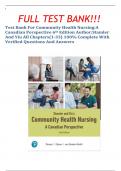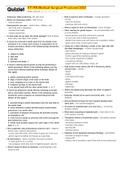1
FULL TEST BANK!!!
,2
TABLE OF CONTENTS
Part One The Context of Community Health Nursing in Canada
1 The History of Community Health Nursing in Canada
2 Policy, Politics, and Power in Health Care
3 Nursing Roles, Functions, and Practice Settings
4 Public Health Nursing
5 Home Health Nursing in Canada
6 Advocacy, Ethical, and Legal Considerations
Part Two Foundations and Tools for Community Health Nursing Practice
7 Theoretical Foundations of Community Health Nursing
8 Health Promotion
9 Race, Culture, and Health
10 Evidence-Informed Decision Making in Community Health Nursing
11 Epidemiology
12 Communicable Diseases
13 Community Nursing Process
14 Community Health Planning, Monitoring and Evaluation
15 Digital Health
Part Three Nursing Care of Selected Populations
16 Maternal, Newborn, and Child Health
17 School Health
18 Family Nursing
19 Gender and Community Health
20 Lesbian, Gay, Bisexual, Transgender, Queer, and Two Spirit Clients
21 Older Adult Health
22 Indigenous Health
23 Community Mental Health
24 Rural and Remote Health
25 Chronic Care, Long-term Care, and Palliative Care
26 Correctional Health
27 Ecological Determinants of Health and Environmental Health Inequalities
Part Four Selected Community Problems
28 Violence and Health
29 Poverty, Homelessness, and Food Insecurity
30 Substance Use
31 Sexually Transmitted and Blood-Borne Infections
32 Emergency Preparedness and Disaster Nursing
Part Five Looking Ahead
33 Global Health
,3
Chapter 1: The History Of Community Health Nursing In Canada
Community Health Nursing A Canadian Perspective 6th Edition Stamler
Multiple Choice Questions
1. Who Would A Visiting Nurse Most Likely Work With In The Early 1900s In Canada?
a. Families Who Could Afford To Pay
b. Poor And Destitute Families
c. The Community
d. School Children
Correct Answer: B (Page 6)
2. Which Community Health Nursing Specialty Emerged In Early 20th-Century Canada To
CombatCommunicable Disease, Infant Mortality, And Childhood Morbidity?
a. Visiting Nursing
b. District Nursing
c. Private Duty Nursing
d. Public Health Nursing
Correct Answer: D (Page 4)
3. In The Early 20th Century, Health Departments Were Dissolved After A Local Emergency Was
Over.Which Statement Below Characterizes The Social Attitude Of The Era?
a. Public Health Was The Responsibility Of Doctors
b. Visiting Nurses Were Responsible For Community Health
c. The State Was Not Responsible For Health Care
d. Women Should Not Be Working Outside Of The Family
Correct Answer: C (Page 3)
, 4
4. What Was The Primary Reason For The Establishment Of School Health Programs?
a. Prevent Ill Children From Becoming Dependent Citizens
b. Promote The Health Of All Children
c. Provide Food For Children Who Lived In Poverty
d. Treat Sick Children So They Could Work And Contribute To The Family Income
Correct Answer: B (Page 4)
5. The Earliest Forms For Healthcare In Canada Were:
a. The Practices Of Aboriginal People
b. European Settlers Who Were Physicians
c. The Wives Of Surgeons
d. The Grey Nuns-First Community Nursing
Correct Answer: A (Page 2)
6. Were Canada’s First Community Nursing Order Who Made
Significant Contributions To Providing Access To Health Services, Food, Shelter, And
Education For The MostVulnerable:
a. The Victorian Order Of Nurses
b. The Grey Nuns
c. Public Health Nurses
d. School Nurses
e. Nursing Sisters -First To Provide Health Care In Remote And Frontier Area)
Correct Answer: B (Page 3)
7. The Dual Mandate Of Doing Charitable Work And Providing Affordable Nursing Care Was
Held ByWhich Agency?
a. The Margaret Scott Nursing Mission
b. The Victorian Order Of Nurses-Lady Aberdeen Led The Development
c. Indian Health Services
d. Public Health Services
Correct Answer: B (Page 4)






